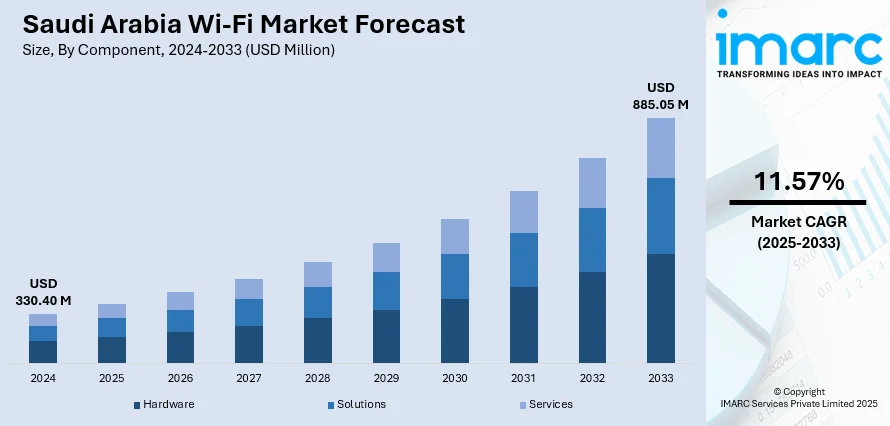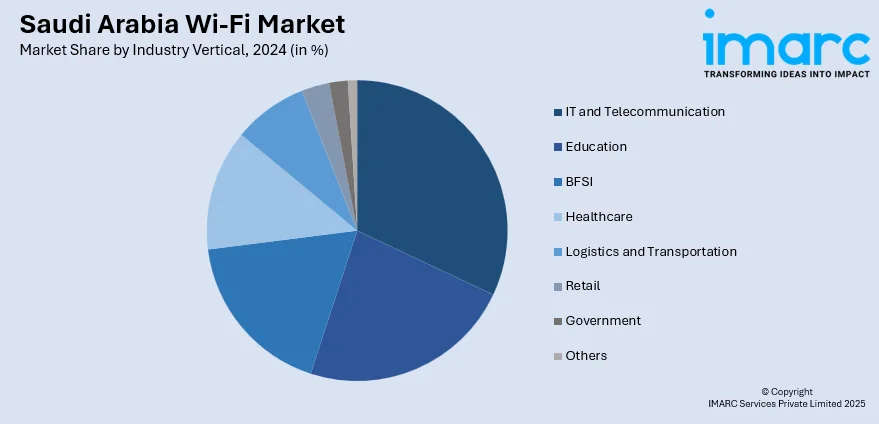
Saudi Arabia Wi-Fi Market Size, Share, Trends and Forecast by Component, Density, Location Type, Organization Size, Industry Vertical, and Region, 2025-2033
Saudi Arabia Wi-Fi Market Overview:
The Saudi Arabia Wi-Fi market size reached USD 330.40 Million in 2024. Looking forward, IMARC Group expects the market to reach USD 885.05 Million by 2033, exhibiting a growth rate (CAGR) of 11.57% during 2025-2033. The expanding deployment of 5G networks, government initiatives to enhance digital infrastructure, increasing IoT device adoption, and the incorporation of wireless connectivity across the healthcare, automotive, and smart home sectors are some of the key factors propelling the market growth.
|
Report Attribute
|
Key Statistics
|
|---|---|
|
Base Year
|
2024 |
|
Forecast Years
|
2025-2033
|
|
Historical Years
|
2019-2024
|
| Market Size in 2024 | USD 330.40 Million |
| Market Forecast in 2033 | USD 885.05 Million |
| Market Growth Rate 2025-2033 | 11.57% |
Saudi Arabia Wi-Fi Market Trends:
Deployment of 5G Networks
The rapid implementation and adoption of 5G networks, fueled by the government's Vision 2030, has been a crucial driver of Saudi Arabia's Wi-Fi industry development. Significant investments in telecommunications infrastructure are being undertaken to fulfill the growing demand for higher internet speeds and more connections. The introduction of 5G is critical because it not only enhances mobile connection but also allows Wi-Fi networks to provide high-speed, low-latency services. This move enables a broader range of applications needing continuous connectivity, such as smart homes, self-driving cars, and industrial IoT solutions. The Saudi government is working closely with major telecom firms such as STC (Saudi Telecom Company) and Zain KSA to build their 5G networks across the country. As Wi-Fi networks integrate with 5G, both businesses and consumers will experience faster internet, improved streaming, and a better overall user experience.

Smart Cities and IoT Integration
The Vision 2030 initiative regarding the development of smart cities has been a crucial driver of Saudi Arabia's Wi-Fi industry growth. Projects such as NEOM, a city planned to be a hub for innovation and sustainability, are hastening the adoption of IoT and smart technology, both of which need powerful Wi-Fi infrastructure. Wi-Fi networks are critical components of smart cities, acting as the foundation for devices such as sensors, security cameras, self-driving cars, and smart appliances. IoT adoption in Saudi Arabia is growing rapidly, with industries like healthcare, transportation, and logistics increasingly relying on interconnected devices. Additionally, the government is extending public Wi-Fi networks in places such as Riyadh and Jeddah to serve up to 80% of the urban population by the end of 2025. This emphasis on smart cities and IoT adoption highlights the relevance of Wi-Fi as a crucial infrastructure component in the Kingdom's digital transformation.
Saudi Arabia Wi-Fi Market Segmentation:
IMARC Group provides an analysis of the key trends in each segment of the market, along with forecasts at the region/country level for 2025-2033. Our report has categorized the market based on component, density, location type, organization size, and industry vertical.
Component Insights:
- Hardware
- Solutions
- Services
The report has provided a detailed breakup and analysis of the market based on the component. This includes hardware, solutions, and services.
Density Insights:
- High-Density Wi-Fi
- Enterprise-Class Wi-Fi
A detailed breakup and analysis of the market based on the density have also been provided in the report. This includes high-density Wi-Fi and enterprise-class Wi-Fi.
Location Type Insights:
- Indoor
- Outdoor
The report has provided a detailed breakup and analysis of the market based on the location type. This includes indoor and outdoor.
Organization Size Insights:
- Large Enterprises
- Small and Medium-sized Enterprises
A detailed breakup and analysis of the market based on the organization size have also been provided in the report. This includes large enterprises and small and medium-sized enterprises.
Industry Vertical Insights:

- IT and Telecommunication
- Education
- BFSI
- Healthcare
- Logistics and Transportation
- Retail
- Government
- Others
A detailed breakup and analysis of the market based on the industry vertical have also been provided in the report. This includes IT and telecommunication, education, BFSI, healthcare, logistics and transportation, retail, government, and others.
Regional Insights:
- Northern and Central Region
- Western Region
- Eastern Region
- Southern Region
The report has also provided a comprehensive analysis of all the major regional markets, which include Northern and Central Region, Western Region, Eastern Region, and Southern Region.
Competitive Landscape:
The market research report has also provided a comprehensive analysis of the competitive landscape. Competitive analysis such as market structure, key player positioning, top winning strategies, competitive dashboard, and company evaluation quadrant has been covered in the report. Also, detailed profiles of all major companies have been provided.
Saudi Arabia Wi-Fi Market News:
- April 2025: The King Abdullah Financial District Development and Management Company (KAFD DMC) launched a Smart WiFi-7 service in conjunction with Huawei. The service will reportedly improve connection and digital infrastructure for all area residents, visitors, and tenants.
- April 2025: Riyadh Air partnered with Viasat to equip its Boeing 787 Dreamliner fleet with advanced in-flight Wi-Fi. This collaboration was aimed at providing passengers with free, high-speed, and seamless streaming connectivity, enhancing the travel experience. The Wi-Fi service was designed to integrate fully with Riyadh Air's digital ecosystem, offering personalized and uninterrupted internet access throughout the flight.
Saudi Arabia Wi-Fi Market Report Coverage:
| Report Features | Details |
|---|---|
| Base Year of the Analysis | 2024 |
| Historical Period | 2019-2024 |
| Forecast Period | 2025-2033 |
| Units | Million USD |
| Scope of the Report | Exploration of Historical Trends and Market Outlook, Industry Catalysts and Challenges, Segment-Wise Historical and Future Market Assessment:
|
| Components Covered | Hardware, Solutions, Services |
| Densities Covered | High-Density Wi-Fi, Enterprise-Class Wi-Fi |
| Location Types Covered | Indoor, Outdoor |
| Organization Sizes Covered | Large Enterprises, Small and Medium-sized Enterprises |
| Industry Verticals Covered | IT and Telecommunication, Education, BFSI, Healthcare, Logistics and Transportation, Retail, Government, Others |
| Regions Covered | Northern and Central Region, Western Region, Eastern Region, Southern Region |
| Customization Scope | 10% Free Customization |
| Post-Sale Analyst Support | 10-12 Weeks |
| Delivery Format | PDF and Excel through Email (We can also provide the editable version of the report in PPT/Word format on special request) |
Key Questions Answered in This Report:
- How has the Saudi Arabia Wi-Fi market performed so far and how will it perform in the coming years?
- What is the breakup of the Saudi Arabia Wi-Fi market on the basis of component?
- What is the breakup of the Saudi Arabia Wi-Fi market on the basis of density?
- What is the breakup of the Saudi Arabia Wi-Fi market on the basis of location type?
- What is the breakup of the Saudi Arabia Wi-Fi market on the basis of organization size?
- What is the breakup of the Saudi Arabia Wi-Fi market on the basis of industry vertical?
- What are the various stages in the value chain of the Saudi Arabia Wi-Fi market?
- What are the key driving factors and challenges in the Saudi Arabia Wi-Fi market?
- What is the structure of the Saudi Arabia Wi-Fi market and who are the key players?
- What is the degree of competition in the Saudi Arabia Wi-Fi market?
Key Benefits for Stakeholders:
- IMARC’s industry report offers a comprehensive quantitative analysis of various market segments, historical and current market trends, market forecasts, and dynamics of the Saudi Arabia Wi-Fi market from 2019-2033.
- The research report provides the latest information on the market drivers, challenges, and opportunities in the Saudi Arabia Wi-Fi market.
- Porter's five forces analysis assist stakeholders in assessing the impact of new entrants, competitive rivalry, supplier power, buyer power, and the threat of substitution. It helps stakeholders to analyze the level of competition within the Saudi Arabia Wi-Fi industry and its attractiveness.
- Competitive landscape allows stakeholders to understand their competitive environment and provides an insight into the current positions of key players in the market.
Need more help?
- Speak to our experienced analysts for insights on the current market scenarios.
- Include additional segments and countries to customize the report as per your requirement.
- Gain an unparalleled competitive advantage in your domain by understanding how to utilize the report and positively impacting your operations and revenue.
- For further assistance, please connect with our analysts.
 Request Customization
Request Customization
 Speak to an Analyst
Speak to an Analyst
 Request Brochure
Request Brochure
 Inquire Before Buying
Inquire Before Buying




.webp)




.webp)












